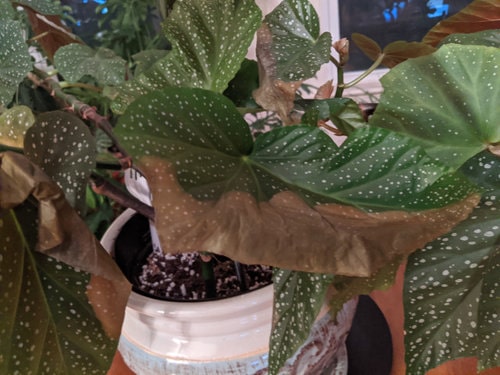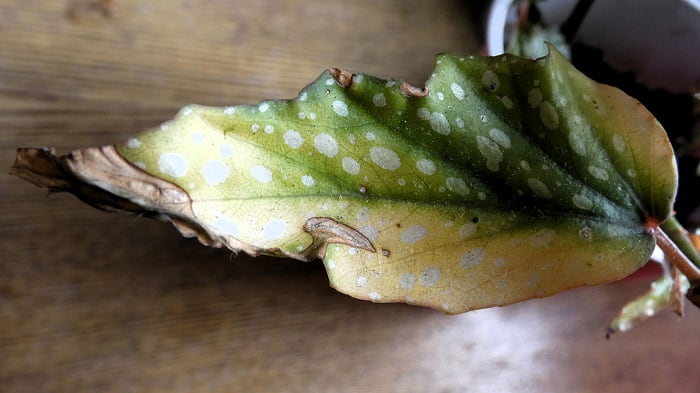Plant Care
Everything You Need to Know About Begonia Plants

Begonia plants are one of the lively plants that come with detailed leaves, making one an ideal colorful houseplant for home decorations. Being native to Brazil where the temperature is high, this plant enjoys the warm room temperature and some bright, indirect light and moisture.
How to Grow and Care for Begonia Plant?
Here is a guide on how to care for your Begonia plant at home. It includes instructions on the appropriate light, water, humidity, temperature, and extra care to help the plant thrive in and survive.
Polka Dot Begonia
· LIGHT

Polka Dot Begonia is a type that thrives well in a spot with bright and indirect light. Although the plant can tolerate medium light, it will still lookout for the bright light. It becomes weak when it lacks light, but it cannot stand full and direct sun exposure.
· WATER
Polka Dot Begonia plant prefers watering when soil is dry. It loves thorough watering, but make sure that the soil is well-drained. Excess water should also be removed from the saucer to prevent the plant from sitting in water and the roots from rotting. It is best to let the soil dry up to 2” to 3” before watering again.
· TEMPERATURE
Polka Dot Begonia thrives well in a room or indoor space with an average of 60 to 80 degrees temperature.
· HUMIDITY
Polka Dot Begonia enjoys extra humidity. You can use a humidifier and a pebble tray near the plant.
· FOOD
Polka Dot Begonia needs plant food, too. You can feed it once a month using plant fertilizer diluted in water. Half of the recommended strength should be applied on top of the soil and not on the leaves.
· TOXICITY
Polka Dot Begonia is a toxic plant that should be kept away from pets.
· ADDITIONAL CARE
Although Polka Dot Begonia loves a humid environment, misting its leaves with water is not a good idea. Its leaves tend to develop powdery mildew when wet. However, misting around the area where the plant is located is helpful if you intend to increase humidity.
Common Problems in Caring for Begonia
Why the edges of the leaves of the Begonia plant turn brown?

Although it is frustrating to find the leaves of your Begonia plant slowly turning brown on the edges, it is not a reason to worry. Let’s see why this is happening to the plant!
· There is a Problem in Watering
One of the reasons is because the plant lacks water. It suffers from inconsistent or irregular watering. When the soil is too dry, the plant becomes dehydrated. The best way to prevent brown edges on leaves, don’t wait half of the soil to dry out before watering. However, the plant hates soggy soil, so make sure that any excess water is removed, especially after watering. If the soil is extremely dry, it is best to soak the plant in water. Here’s how:
How to soak Begonia in the water?
- In a sink, basin, or tub filled with 3” to 4” of water, place the potted Begonia plant. See to it that the water you use is not warm or hot.
- Leave the plant soaking in water for 45 minutes. The water should get in through the pot’s drainage hole in the bottom.
- Check if the soil absorbed the water after 45 minutes. The top part of the soil should be damp.
- If the top part of the soil is still dry, let water flow from the top slowly to allow the soil to absorb it.
- After a while, drain the basin or sink. Make sure that there is no water left on it. After a few minutes of resting, put back the plant to its place in your home.
· There is a Problem in Humidity
Begonia plant needs humidity. To increase humidity in your space, you can add a pebble tray near or under the pot, or use a humidifier to add moisture in the room. Misting the Begonia plant is not an option, but misting the room may help. However, make sure that the water will not land on the leaves of the plant because Begonia is prone to powdery mildew.
· There is a Problem in Lighting
Bright and indirect light is the perfect light for the Begonia plants, whether it is kept indoors or outdoor. If the plant is exposed long under full and direct sunlight, the leaves may get sunburned and turn into brown edges.
Why the leaves of the Begonia Plant turn yellow?

· Overwatering
Overwatering is one of the reasons why the leaves of the Begonia plant turn yellow. The soil is left soggy and wet, which also affects the roots. On the other hand, this problem can be easily fixed. The best way to water the plant is to allow it to soak in water for a while until water flows through the drainage holes. Let the water drain well every time you water the plant, and remove excess water left in the saucer to prevent roots from rotting.
· Low Light
If the plant did not get enough light, its leaves will turn yellow. The lower light condition makes the plant unhealthy. It may take a long while for the plant to absorb the water and nutrients you supply if bright light is not provided. To fix the problem, you can place your potted Begonia plant near the windowsill where it can get enough light that it needs every day.
